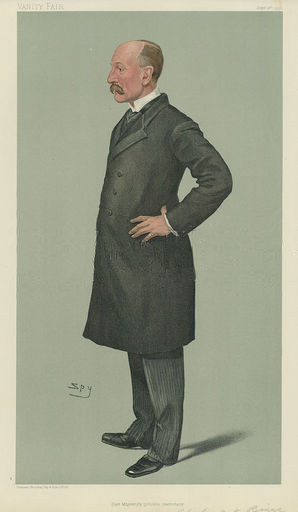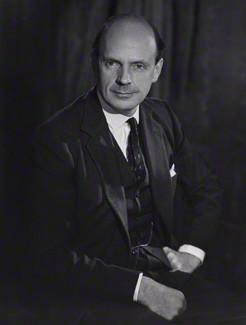
The Order of Merit is an order of merit for the Commonwealth realms, recognising distinguished service in the armed forces, science, art, literature, or the promotion of culture. Established in 1902 by Edward VII, admission into the order remains the personal gift of its Sovereign—currently Edward VII's great-great-grandson Charles III—and is restricted to a maximum of 24 living recipients from the Commonwealth realms, plus honorary members. While all members are awarded the right to use the post-nominal letters OM and wear the badge of the order, the Order of Merit's precedence among other honours differs between countries.
The Master of the Buckhounds was an officer in the Master of the Horse's department of the British Royal Household. The holder was also His/Her Majesty's Representative at Ascot. The role was to oversee a hunting pack; a buckhound is smaller than a staghound and used for coursing the smaller breeds of deer, especially fallow deer. The position was abolished by the Civil List Act 1901.

The Royal Red Cross (RRC) is a military decoration awarded in the United Kingdom and Commonwealth for exceptional services in military nursing. It was created in 1883 and the first two awards were to Florence Nightingale and Jane Cecilia Deeble. Deeble had served in Zululand and she had noted that the work of the nurses was not recognised officially.

The Groom of the Stool was the most intimate of an English monarch's courtiers, initially responsible for assisting the king in excretion and hygiene.
The orders, decorations, and medals of Canada comprise a complex system by which Canadians are honoured by the country's sovereign for actions or deeds that benefit their community or the country at large. Modelled on its British predecessor, the structure originated in the 1930s, but began to come to full fruition at the time of Canada's centennial in 1967, with the establishment of the Order of Canada, and has since grown in both size and scope to include dynastic and national orders, state, civil, and military decorations; and various campaign medals. The monarch in right of each Canadian province also issues distinct orders and medals to honour residents for work performed in just their province. The provincial honours, as with some of their national counterparts, grant the use of post-nominal letters and or supporters and other devices to be used on personal coats of arms.

The Royal Archives, also known as the King's or Queen's Archives, is a division of The Royal Household of the Sovereign of the United Kingdom. It is operationally under the control of the Keeper of the Royal Archives, who is customarily the Private Secretary to the Sovereign. Although sovereigns have kept records for centuries, the Royal Archives was formally established as recently as 1912 and occupies part of the Round Tower of Windsor Castle. Since the Royal Archives are privately owned, requests for public access must be approved based on the needs and qualifications of the researcher.

The Keeper of the Privy Purse and Treasurer to the King/Queen is responsible for the financial management of the Royal Household of the Sovereign of the United Kingdom. The officeholder is assisted by the Deputy Treasurer to the King/Queen for the management of the Sovereign Grant, currently Sally O'Neill.

Robin Berry Janvrin, Baron Janvrin, is a British naval officer, diplomat, and courtier who was private secretary to Elizabeth II from February 1999 to September 2007.
The Royal Victorian Medal (RVM) is a decoration established by Queen Victoria in April 1896. A part of the Royal Victorian Order, it is a reward for personal service to the Sovereign or the royal family, and is the personal gift of the Sovereign. It differs from other grades of the order in appearance and in the way it is worn.

The Knollys family, Knolles or Knowles, is an English noble family descended from Sir Thomas Knollys, Lord Mayor of London, possibly a kinsman of the celebrated general Sir Robert Knolles. The next distinguished member of the family was Sir Francis Knollys or Knowles, English statesman, son of Sir Robert Knollys, or Knolles, a courtier in the service and favour of Henry VII and Henry VIII. Robert had also a younger son, Sir Henry, who took part in public life during the reign of Elizabeth I and who died in 1583. Lettice Knollys was pronounced the most prominent member of the family, from her birth in 1543 until her death in 1634.

Lieutenant-Colonel Arthur John Bigge, 1st Baron Stamfordham, was a British Army officer and courtier. He was Private Secretary to Queen Victoria during the last few years of her reign, and to George V during most of his reign. He was the maternal grandfather of Lord Adeane, Private Secretary to Elizabeth II from 1953 to 1972.

Lieutenant-Colonel Martin Michael Charles Charteris, Baron Charteris of Amisfield, was a British Army officer and courtier of Queen Elizabeth II. Charteris was the longest-serving Assistant Private Secretary to the Sovereign, having served for over 18 years in that position. Later, he became Private Secretary to the Sovereign.

The Honourable George Edward Adeane was an English barrister and royal advisor who served as Private Secretary to the Prince of Wales from 1979 to 1985.

Sir John Ponsonby Conroy, 1st Baronet, KCH was a British Army officer who served as comptroller to the Duchess of Kent and her young daughter, Princess Victoria, the future Queen of the United Kingdom.
Honouring individuals buried in Westminster Abbey has a long tradition. Over 3,300 people are buried or commemorated in the abbey. For much of the abbey's history, most of the people buried there besides monarchs were people with a connection to the church – either ordinary locals or the monks of the abbey itself, who were generally buried without surviving markers. Since the 18th century, it has become a prestigious honour for any British person to be buried or commemorated in the abbey, a practice much boosted by the lavish funeral and monument of Sir Isaac Newton, who died in 1727. By 1900, so many prominent figures were buried in the abbey that the writer William Morris called it a "National Valhalla".
The royal households of the United Kingdom consist of royal officials and the supporting staff of the British royal family, as well as the royal household which supports the sovereign. Each member of the royal family who undertakes public duties has their own separate household.

Victoria, Queen of the United Kingdom of Great Britain and Ireland and Empress of India, died on 22 January 1901 at Osborne House on the Isle of Wight, at the age of 81. At the time of her death, she was the longest-reigning monarch in British history. Her state funeral took place on 2 February 1901, being one of the largest gatherings of European royalty.

Mary Constance Charteris, Countess of Wemyss and March, styled Lady Elcho from 1883 to 1914, was an English society hostess and an original member of The Souls, an exclusive social and intellectual group.

The first season of The Crown follows the life and reign of Queen Elizabeth II. It consists of ten episodes and was released on Netflix on 4 November 2016.













